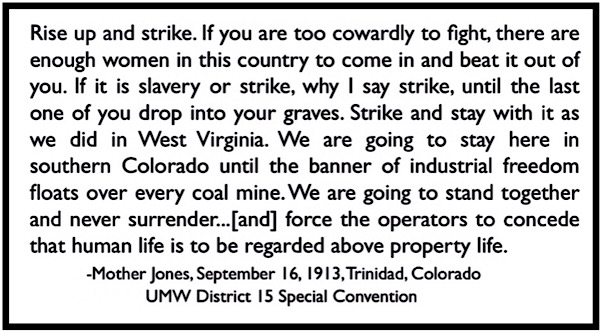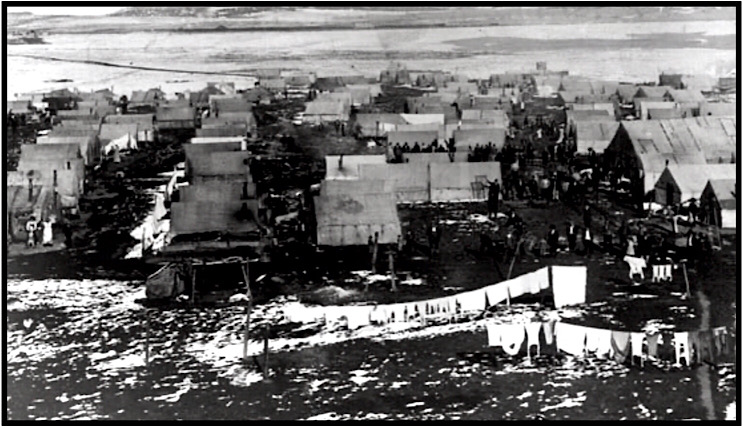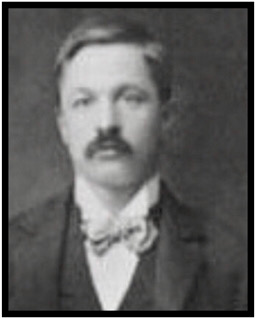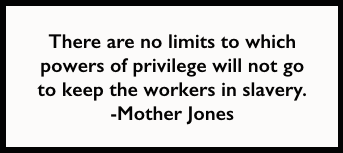 —————
—————
Hellraisers Journal – Sunday February 8, 1914
Trinidad, Colorado – Mother Jones Seized by Soldiers, Held Incommunicado
From the International Socialist Review of February 1914:
 —————
—————
Hellraisers Journal – Sunday February 8, 1914
Trinidad, Colorado – Mother Jones Seized by Soldiers, Held Incommunicado
From the International Socialist Review of February 1914:
 —————
—————
Hellraisers Journal – Thursday December 4, 1913
Coal Miners of Southern Colorado Are Fighting to Win, Part II
From the International Socialist Review of December 1913:
[Part II of II]
Some one has said, “A fool in revolt is infinitely wiser than a learned philosopher apologizing for his chains.” Believing this, fully 95 per cent of the miners answered the call to strike [September 23, 1913]. Men with families within three days of starvation and without clothes enough to protect their frail bodies from the biting winds of mountain winters came out fully determined to win or die in the attempt. And who will blame them? Work such as the miner does is no longer honorable but has come to mean “drunkenness, vice and superstition.” It makes men and women unscrupulous, hard and restless. It destroys for others the treasure of life-a home. All the noble sentiments of liberty and the joy of labor mean in reality to the miner slavery of the worst type.
With thoughtless hymns of praise of this massacreing of labor, society allows one wholesale slaughter after another without a protest. While I am writing this the news arrived of the Dawson, New Mexico, disaster, in which the lives of 261 miners were lost and the operators refused to allow Secretary Doyle of the miners’ union to give the widows and orphans $1,000 donated by the union because the camp was non-union. And just as certain as that nothing becomes better without the desire to improve it so it is a healthy sign of the times that starvation wages for conscientious drudgery no longer fills the miner with heartfelt gratitude toward the master class.
The mine slaves were so cowed that the operators were sure that not more than 25 per cent would quit and when practically every miner laid down his tools, completely tying up the coal industry of Colorado, the wrath of the masters knew no bounds. They immediately got busy and sent a deputation of their lackeys, consisting of a lawyer, banker and a Catholic priest (Father Malone), to Washington to repeat the lies of the operators that the miners were satisfied with conditions but forced to strike by eastern agitators like Frank Hayes and Mother Jones. Their thugs began to terrorize the country, shoot up the tented camps of the strikers, insult the women and abuse the children and the operators began to call for the militia that the state might pay the cost of breaking the strike and thus save John D. a few paltry dollars with which to build a few more churches and start more Sunday schools where they sing and PREY-“servants obey your masters.”
Failing to get the militia as soon as they called, the operators had to content themselves with filling the jails of Colorado with strikers who dared to exercise their constitutional rights of peacefully asking imported strikebreakers to not work. In the city of Boulder and within the shadow of Colorado’s greatest educational institution, the state university, thirty-six were confined in the county jail until the court permitted the prisoners to bail each other out. Forty-nine others were arrested in Las Animas county and marched seven miles to the Trinidad jail between two rows of armed guards with Belk and Beltcher (out on bond for murder of Lippiatt), following up the rear with a Gatling gun mounted on an armored automobile.
Frank Hayes says, “The operators have several machine guns mounted on autos. They also have what is known as the ‘steel battle ship [Death Special].‘ This is an automobile with a high body of solid sheet steel built up so as to almost conceal the guard inside. The steel furnishes resistance to the bullets and is so arranged that the assassins on the inside may shoot their rifles in perfect safety. It is a splendid refuge for a coward. The body of the machine is shaped like a torpedo and was designed and built for mine guards. It carried a rapid fire machine gun with a range of more than two miles. As bad as West Virginia was there was nothing down there to compare with this latest instrument of murder that the operators of Colorado are using.”
As this procession neared town, G. E. Jones, a member of Western Federation of Miners, attempted to get a picture of the armored car. A. C. Felt beat him insensible and destroyed his camera and had him arrested for disturbing the peace.
Gun men patrol the public roads in armored autos, shooting up first one camp and then another. The first resistance the strikers offered was at Forbes, October 17, one striker was killed, two wounded and a deputy shot in the hip. One hundred and forty-seven bullets from a machine gun passed through a tent occupied by an aged Scotchman, who saved his life by lying flat on the floor. After this battle the miners made preparations to defend themselves from further attacks of the guards.
 —————
—————
Hellraisers Journal – Wednesday December 3, 1913
Coal Miners of Southern Colorado Are Fighting to Win, Part I
From the International Socialist Review of December 1913:
[Part I of II]
”THE fight is on. We would have avoided it; we still stand ready at any time to meet representatives of the other side with hopes of effecting a settlement. We hold out the olive branch continually. But because we wish for peace must not be construed as a sign that we are not able to fight. Our past record should dispel such idle dreams. We will aid our brothers in the Colorado fields with all of our resources; with the advice of men of experience; with the hearty good will and sympathy of the vast army of sturdy workers that make up our membership. And these will give a good account of themselves against all the powers of darkness the operators may bring against us.”-Mine Workers Journal.
For months the leading newspapers (?) of Denver and all the capitalist sheets throughout the state, both daily and weekly have been repeating the same rigmarole in regard to the coal strike. While they insult the union men, they anxiously defend themselves against any suspicious of sympathy with the Standard Oil crowd. Their excuses are: A strike is an industrial war for more wages and not one of principle, it does not in their opinion affect the question of morality; finally, even if right and justice is on the side of the miner it is a vain attempt to subjugate by force of a strike, the peaceful relations of No. 26 Broadway [Rockefeller’s HQ in New York City]. Would not open shop conditions free the miner of all his trouble? Therefore, should not the miners welcome the open shop as a happy event instead of seeking a recognition of the union through a “bloody and ruinous strike”?
Let us look a little into the real cause of this strike that dates, back to April 1, 1910, a time when there were not over three thousand organized miners in the state. Our contract expired then and the operators knew we would never be any weaker and perhaps they never more powerful. Therefore they sought to force an open shop by refusing to recognize the miner’s right to organize and sell his labor-power collectively. A strike resulted, one that history will perhaps record as the hardest fought mile of the miner’s road to industrial freedom.
There were but few of us and after several months the busy world outside forgot all about the strike in northern Colorado. Strikes were fought and won in various parts of the country; all the while the miners stood firm, fighting injunctions, suffering jail sentences and other hardships without complaining, yet knowing all the time our only hope for victory was an organized strike in the southern part of the state, as we were unable to seriously affect the market. National organizers were sent south and at once began the task of secretly organizing the slaves in John D.’s hell-holes of Colorado. This work was slow and dangerous requiring three and one-half years’ time (and “God knows” how much cash).
When the civil war was ended in West Virginia the militant workers of the union, including Frank J. Hayes and “Mother Jones” were sent to Colorado to assist in the organization work and with their arrival things began to move apace. Hayes soon asked the operators for a conference and demanded recognition of the union in the name of 15,000 newly organized slaves. The operators ignored all invitations to arbitrate boasting they had five millions of dollars for defense. They began preparing for a strike by importing gun men and thugs from West Virginia through the Baldwin Feltz detective agency. W. H. Reno, chief detective for C. F. & I., also opened a recruiting station in the Dover Hotel, 1744 Glenarm place, and succeeded in sending out of Denver some of the most notorious characters from the red light district and barrel house bums. Upon the arrival of these criminals in the strike zone Sheriffs Gresham and Farr (appointed by the coal companies), gave them deputy sheriff commissions.
The State Federation of Labor held its annual convention at Trinidad August 18 and when the U. M. W. of A. delegates began to arrive in town late Saturday afternoon G. W. Beltcher and Walter Belk, two Baldwin-Feltz heroes, shot and instantly killed Gerald Lippiatt, a district organizer on the main street of Trinidad. A coroner’s jury, composed of “good” business men, rendered a verdict of “justifiable homicide”; District Attorney Hendricks later preferred a charge of murder against them but the courts of Colorado do not value a coal miner’s life very high and Lippiatt’s murderers were promptly released on bond because such human hyenas are needed by the operators to maintain law and order during a strike.
 —————
—————
Hellraisers Journal – Saturday November 22, 1913
Trinidad, Colorado – Baldwin-Felts Gunthug Belcher Shot and Killed
Headline from the Trinidad Chronicle News of November 21, 1913:
Friday November 21, 1913-Trinidad, Colorado
-Baldwin-Felts Gunthug George W. Belcher Shot and Killed
At about 7:30 last evening the notorious Baldwin-Felts gunthug, George W. Belcher, 26, of West Virginia, was shot and killed as he left the Hausman Drugstore across from the Columbian Hotel in Trinidad. Belcher died at the scene. A striking miner, Louis Zancanelli, was arrested shortly after the shooting by city policemen. Belcher was well known throughout the strike zone for his role in the killing of Brother Gerald Lippiatt in Trinidad in August. He was deputized by Huerfano Sheriff Jefferson Farr in June. He played a part in the attack on the Ludlow Tent Colony in October in which Brother Mack Powell was shot off his horse and killed. Later in October, he was found in the Death Special, lurking about Forbes, by John Lawson and Louie Tikas the morning after the attack on the Forbes Tent Colony which left Brother Luca Varhernick dead. At that time, Belcher was found in the Death Special along with his fellow gunthug Walter Beck and Judge Northcutt [publisher of the Trinidad Chronicle News], attorney for the mine operators.
Along with Belcher, Belk was also sworn in as a Huerfano County deputy which gave them both a license to kill striking miners. Northcutt signed on as defense attorney for Belcher and Belk soon after the murder of Brother Lippiatt. Northcutt is also the attorney for the mine operators, and works with District Attorney Hendrick in the prosecution of striking miners.
Any chance of a fair trial for Louis Zancanelli seems slim.
 —————
—————
Hellraisers Journal – Sunday October 26, 1913
News Round-Up from the Coal Miners’ Strike in Southern Colorado
From The Rocky Mountain News of October 25, 1913:
Saturday October 25, 1913
Southern Coalfield, Colorado – Mine guards and deputies continue reign of terror.
Forbes Tent Colony, October 23–At dawn today, Under-Sheriff Zeke Martin and fifty deputies, some of them deputized company gunthugs, brought the Death Special back to the small colony. They surrounded the colony with four machine guns pointed at the terrified residents. The men were rounded up and held at gunpoint. The women and children were forced from their beds. The tents were torn apart, trunks, beds, and floorboards, in a search for guns. Four of the striking miners were arrested and taken away for the death of Luca Vahernick, the striker who was murdered by the gunthugs that ambushed the colony on the 17th.
Walsenburg, October 24–Thirty heavily armed company guards and deputy sheriffs rode their horses into town today. They came to escort a scab’s wife into the stockade of the Walsen Mine. Strikers, along with their wives and children, gathered and began shouting and jeering, “Scab herders, scab herders!” Some of the children threw dirt clods. Without warning, the deputies opened fire. They fired several times, and then rode off leaving two dead strikers (Andy Auvinen and Cisto Croci) and one dying (Kris Kokich) in the street behind them. These brother-miners join Gerald Lippiatt, Mack Powell, and Luca Vahernick as the martyrs, thus far, of the miners’ strike in the coalfields of southern Colorado.
Sheriff Farr and 50 deputies barricaded themselves in the courthouse as strikers and sympathizers in the town of Walsenburg picked up their guns and called for vengeance.
 —————
—————
Hellraisers Journal – Tuesday October 14, 1913
Ludlow Colony, Colorado – Gunthugs Attack Strikers’ Tent Village
 The Ludlow Tent Colony
The Ludlow Tent Colony
Wednesday October 8, 1913
Ludlow Tent Colony – Gunthugs fire into tents, miners rally to defend the camp.
Several striking miners walked up to Hastings from Ludlow yesterday attempting to collect their mail from the U. S. Post Office there. When mine guards refused them their mail, they argued briefly, but then headed back toward Ludlow. The guards laughed and fired shots over their heads as they walked away.
A short while later, Walter Belk and George Belcher, the same Baldwin-Felts gunthugs who were involved in the murder of Brother Lippiatt, drove near to Ludlow and let loose with a volley of shots into the tents. When miners came running to defend the Colony, more guards began shooting. The miners took up their guns and returned fire.
Women and children ran from the tents and gathered at the fence on the west side of the camp. Seeing that they were exposed to fire, John Lawson ran along the fence urging the women and children back to the tents. As the miners forced the guards to retreat, the women and children, singing union songs, returned to camp.
There are reports that shots were fired at the camp again this morning. John Lawson urged the miners not to leave the camp in pursuit of the guards, but to stay close by:
While you fellows run down there a mile or so the Hastings guards will come down and take the tent colony.
The miners are taking Lawson’s advice. They remain in the camp with their rifles close at hand.
———-
Friday October 10, 1913
Ludlow Tent Colony – Gunthugs fire on baseball field, kill Mack Powell.
Yesterday morning gunthugs from Hastings fired upon the baseball field at the edge of the camp. Striking miners had been enjoying a friendly game, but, as bullets hit the dirt around them, they quickly ran for their rifles. They were able to drive the guards away from the camp. Mack Powell was sitting on his horse and watching from a distance when he was struck by a bullet and killed. Guards were later heard to brag that they had killed a miner.
Mack Powell was a union miner who had taken work as a cowboy on the near-by Green Ranch. Mack was married, and lived with his wife and his wife’s grandmother.
———-
Sunday October 12, 1913
Southern Coalfield – Operators ship in machine guns; Union prepares.
Should any American citizen believe that, surely, those mine guards who shot up the Ludlow Tent Colony and killed Mack Powell have been arrested, let them be, here and now, disabused of that naive notion of equal justice. In fact, the guards have not been arrested; they have had four machine guns added to their supply of weapons with which to continue their attacks on the tent colonies.
Vice President Hayes of the United Mine Workers of America said recently to John Lawson, “But they can’t conduct a war against us with machine guns. They wouldn’t turn machine guns on defenseless people.”
John Lawson believes that the operators are just that ruthless, and said, “We’ve got to protect the women and children at all costs.”
The colonies have been directed to put up breastworks and to dig pits under the tents. The women and children will be able to shelter there whenever the colonies are attacked. At this time, the Ludlow colony is the particular focus of the gunthugs, but all of the 20 or more colonies are considered to be at risk.
———-
 —————
—————
Hellraisers Journal – Tuesday August 26, 1913
Trinidad, Colorado – State Federation of Labor to Support Mine Workers’ Strike
From the Denver United Labor Bulletin of August 23, 1913:
Gerald Lippiatt
Shot Down by Gunthugs at Age 38

Gerald Lippiatt did not come into Trinidad looking for fight. He was a striker from the northern field who was in the southern field working as an organizer. But, sadly, he took the bait when George Belcher and Walter Belk, two well-known Baldwin-Felts gunthugs, began to butt him with their elbows as he attempted to walk around them on Commercial Street. Other gunmen joined in, cursing him as they lurked about on the sidewalk, smoking their cigarettes.
Brother Lippiatt headed to the Packer block for his gun. Several of his fellow organizers in the union office tried to stop him to no avail.
“All right, you rat, let’s have it out,” Lippiatt shouted at Belk. The professional gunthug knew his business, and Lippiatt was soon lying dead in the center of the street.
The Colorado State Federation of Labor met for their yearly convention in Trinidad two days after the killing of Brother Lippiatt. The chair which would have been occupied by Lippiatt was draped in black. Perhaps, Brother Lippiatt was on their minds as they voted their support to District 15 of the United Mine Workers of America for any action deemed necessary with respect to conditions in the southern coalfields. Efforts were underway to avoid a strike against coal operators of southern coalfields, but the likelihood of avoiding that strike was fading with each passing day.
The coffin of Brother Lippiatt left Trinidad accompanied by the delegates from northern Colorado who were returning home from the C. F. of L. Convention. Gerald Lippiatt was brought home to Colorado Springs for burial. As the flag-draped coffin was taken from the baggage car and loaded onto the hearse, the delegates stood silently by, hats in hand, remembering who was responsible for his murder.
It was the sad duty of John McLennan, President of District 15 of the UMWA, to call John Lawson, International Board Member, at his home in Denver to inform him of Lippiatt’s death. Lawson related the conversation he had with Lippiatt three days before his death:
“I am leaving for Trinidad tonight, John, and I want to tell you goodbye. I think I am going to be killed”
“Killed? What do you mean?”
“The gunmen have been pressing me pretty hard down there, John, but I am going back. I’ve got a hunch they are going to get me this time.”
“Then you mustn’t go. Stay here and we’ll send someone else down; someone who isn’t so well known to them.”
“No, John, I’m going back. It is my job, and I want to go. But this is my last trip. Goodbye.”
Gerald Lippiatt was born in England in 1874, and came to America in 1891 with his parents and five siblings. The family settled in Ohio. He was survived by an older brother in Colorado Springs. He was engaged to be married to Edith Green of Rugby. He was likely a father as Martelle mentions a descendant. He had been Secretary of the UMWA local union in Frederick, Colorado, and was active in the northern coalfield strike before being sent to the southern field as an organizer.
 —————
—————
Hellraisers Journal – Tuesday August 19, 1913
Trinidad, Colorado – Brother Gerald Lippiatt Shot Down by Gunthugs
From the Trinidad Chronicle-News of August 18, 1913:
From The San Francisco Call of August 18, 1913:
 ———-
———-
Hellraisers Journal – Sunday May 23, 1920
Matewan, West Virginia – Gunthug Brothers Invade the Wrong Town
From The Butte Daily Bulletin of May 22, 1920:
———-